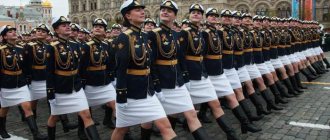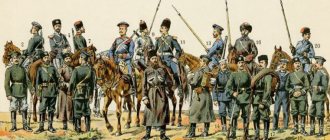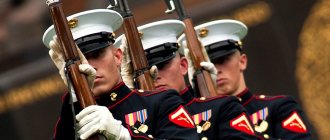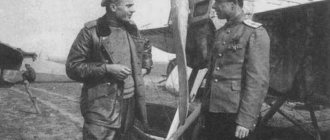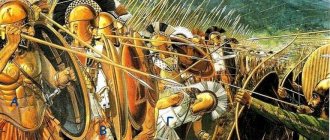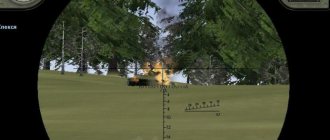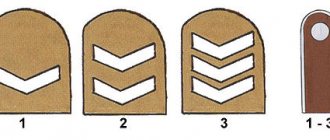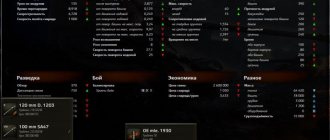Psychology and history of uniforms
Every person has to wear a uniform more than once in their life. Everyone’s attitude towards this phenomenon is different, just as its social meaning and perception by many people differ. The main purpose of wearing any uniform is to show that a person belongs to a certain type of activity or social class.
Since ancient times, wearing certain clothes has determined a person's social status: better furs and fabrics are a sign of higher status in society. The very first military uniform in human history was the scarlet cloak worn by the Spartan warriors in Ancient Greece. Later, chain mail and coat of arms insignia on shields and flags became a distinctive attribute of the military.
Then uniforms began to appear not only as belonging to military personnel, but also clothing for schoolchildren and factory workers. In the Russian Empire, the first school uniform appeared in 1834 and became a source of pride for gymnasium students.
Wearing a military uniform embodies the idea of control and carries coded information about a person. A military man wearing a uniform is subject to certain rules, compliance with which is clearly defined by the regulations. This imposes some obligations and imprint on the personality, determines the rules of his behavior. Deviations from them are associated with disobedience and even sabotage, with the manifestation of individuality. Thus, wearing any uniform has a dual meaning on the person who wears it.
Wearing military uniforms and standard uniforms has a disciplinary effect on people and helps to influence the mind and body, since it presupposes the formation of a certain physique and military bearing. However, it also necessitates subordination, the transformation of the individual strength of one person into the collective power of an army. Military uniform is also an ideological tool, a means of shaping physical and mental activity.
History of Russian military clothing
In Ancient Rus' there was practically no uniform for the military, since there were no permanent troops. Until the 17th century, each prince had at his disposal a squad, which was dressed in the usual clothes of that time. However, during an attack or defense of the city, its representatives wore protective armor on top.
The first attempt to create the same military uniform (clothing) was made during the formation of the Streltsy regiments in the 17th century. Then red caftans appeared, more than once painted by Russian artists in works of art (“Streltsy” by S. Ivanov and others). Such clothing was called a colored dress, and its color meant belonging to different regiments. There was also a ceremonial uniform that the archers wore during church holidays: it was supplemented with good-quality boots and a fur hat.
Military uniform in pre-Petrine Russia
In the Middle Ages, when the main combat operations were carried out by the squad, there was no special need for uniforms. A heraldic design on a shield or a battle cry was quite enough, not only in wars with foreigners, but also in internecine skirmishes. The militia, which made up the mass army, simply did not have the ability to sew any clothes resembling a uniform.
The maximum that warriors could count on to identify “friend or foe” on the battlefield was colored signs such as feathers or flowers of a certain color attached to their headdresses, or armbands.
With the creation of professional troops, the first samples of uniform clothing for Russian soldiers appeared. This happened during the time of Ivan the Terrible, who was seriously concerned about creating a Streltsy army.
All archers had to wear the same red caftans with white berendeykas, which was the name of a wide leather cross-shoulder belt on which pre-measured powder charges were hung, as well as a bag of bullets and a horn of gunpowder. Regimental differences between rifle regiments are also being introduced.
Each regiment had a cap of a certain color; there could be differences in boots and the color of belts.
Interestingly, armor was rare. The maximum that a wealthy archer of that time could count on was the so-called “iron cap”, or helmet. The command staff was distinguished by a more expensive uniform, as well as a wide sash and cane.
In the 17th century, the form became more complex, and new regiments appeared. A noticeable proportion of the personnel consisted of foreigners, and this contributed to the uniform. Foreign soldiers offered elements familiar to European armies, and the regimental commander often met them halfway, approving the introduction of these elements.
However, tradition remains at the forefront. So, for example, minimal changes occur with the palace guards, known as bells. Their form has not changed since the time of the Rurikovichs.
Army of Peter I
Peter I re-equipped his army immediately after rearmament. The Russian army has already arrived at the walls of the Azov fortress in new shortened caftans. The German uniform became the model for the infantrymen's clothing: Peter's guards were dressed in a dark green cloth caftan, decorated with red cuffs with 4 copper buttons. A scarlet shoulder strap was attached to the left shoulder, onto which the sling of a bag with cartridges was hung. Underneath they wore a vesta camisole, which was fastened with small buttons, and even lower was a white shirt. Pants were made from good cloth, and for cavalrymen - from elk skin, knee-length. Below they wore stockings and blunt-toed shoes. For the hike, they were given boots, and in bad weather, a raincoat with a double collar.
The army and guards units differed in the color of their uniforms: the Semyonovtsy wore red and blue, the Preobrazhentsy wore red and green. Bow ties were also sewn for officers, which were tied around the neck, with the ends hanging down to the chest. the colors differed for different ranks and branches of the military.
The uniform of the officers was distinguished by a richer decor: embroidered gold braid on the cocked hat and caftan, silk multi-colored scarves with tassels (the colors of the Russian flag) and others. However, it was distinguished by its narrow cut and inconvenience when wearing.
Uniform in the army of Catherine and other Russian tsars
During Catherine's reign, Prince Potemkin first raised the question of convenience for soldiers and officers when wearing military uniforms. The tradition of wearing wigs was abolished, and uniforms were replaced with more practical and wide ones; trousers began to be tucked into boots. Soldiers wore helmets on their heads to protect them from saber strikes.
With Paul coming to power, the uncomfortable uniform returned to the army, as did the wearing of wigs and uncomfortable patent leather shoes (which chafed their feet). Moreover, for non-compliance with this form, people could be exiled to Siberia.
Under Alexander II, Russian military uniforms were restored to their aesthetic appearance and comfort. The more spacious cut made it possible to wear warm underwear, which was a salvation for soldiers in the cold winter months. Military overcoats were introduced into use, with a warm cap on top. The cut was chosen to be simpler, so in appearance the Russian military uniform began to resemble peasant clothing. Its production was cheaper, and in order to save money, the king issued a decree that money for uniforms was deducted from the salaries of soldiers and officers.
At the beginning of the 20th century, after the Russo-Japanese War, single-breasted tunics with a stand-up collar were introduced into the uniform set of the Russian military; the color chosen was protective green, the fastener was made with 5 buttons, and pockets were added. Having become popular, this style was called “French” in honor of the British general.
Form after the revolution
After 1917, during the Civil War, the uniform of the Red Army was not unified: the only distinctive feature was a scarlet ribbon with the inscription “Red Guard”, which was worn on a sleeve or hat. In 1918, an original cloth headdress appeared, which was later called “Budenovka” (at first it was called “heroka”). Shoulder straps were abolished, replaced by distinctive squares and triangles that could be used to identify rank and troops.
The wearing of the emblem in the form of a red star was approved in May 1918, which became a symbol of the young state. It was worn on an overcoat, jacket, tunic, etc.
In 1922, the Revolutionary Military Council issued a decree on the transition to new regulated uniforms, and the old uniform was canceled. Much attention was paid to insignia, which were sewn onto the sleeve flap, buttonholes and other forms. They differed in color, shape, etc. The basic uniform consisted of a cloth overcoat and helmet, a tunic shirt, riding breeches, boots or boots. The cloth used was dark gray made of wool, the shirt was gray made of dyed cotton fabric.
From tunics to ceremonial uniforms: how the military uniform of the Red Army changed
Photo: from the personal archive of V. Khabarov
(City of Kazan KZN.RU, February 23, Alina Berezhnaya). On February 23, Russia celebrates Defender of the Fatherland Day. First of all, congratulations are received by veterans, military personnel and representatives of law enforcement agencies. The history of this holiday goes back to 1918, when the Workers' and Peasants' Red Army was created. The head of the department of scientific reconstruction of the National Museum of Tatarstan, Vladislav Khabarov, told readers of the KZN.RU portal how the military uniform has changed over the years.
1918-1920: badges, geometric figures, budenovki
The prototype of the Workers' and Peasants' Red Army were the Red Guard detachments, which began to form after the February Revolution of 1917. The Red Guards did not have a set uniform; they were distinguished only by a red armband with the inscription “Red Guard”.
The commanders wore a “star” framed with a red bow.
Photo: from the archive of V. Khabarov
In January 1918, a decree was signed on the creation of the Workers' and Peasants' Red Army. Red Army soldiers could be distinguished by their breastplate - it was a wreath with a red star on which a hammer and a plow were depicted. The commanders wore a “star” framed with a red bow.
In 1919, an order was issued to introduce uniforms. Famous artists worked on the sketches, including Vasnetsov, Kustodiev and others. This is how heroes appeared, which were later renamed budenovki. There is an opinion that this headdress was invented back in tsarist times, so that in the event of victory in the First World War, wearing winter “helmets”, a victorious march through Berlin would take place. However, according to Vladislav Khabarov, this is just a myth.
The color of the chest flaps indicated belonging to a certain branch of the military.
Photo: From the personal archive of V. Khabarov
A little later, tunics were introduced. By the way, they existed even under Alexander II, soldiers did gymnastics in them, and after the Russo-Japanese War in 1905, this item of clothing became the main item of clothing for the military. The Red Army tunics were fundamentally different from previous samples - they had sewn chest flaps, so-called “conversations”, the color of which indicated belonging to a particular branch of the army: crimson for infantrymen, black for sappers, blue for cavalrymen. The same colored “conversations” were sewn on overcoats. The exact origin of this name is still unknown. According to one version, “conversations” refers to the Old Russian word “raz”, which meant “to divide.” “Conversations” were also called braids that were sewn onto clothes. Also, the word “raz” in the peasant dialect meant the smell of outerwear. In this case, clothes that “talk” are clothes with a wrap.
Leon Trotsky's security uniform: red leather jackets, trousers, Budenovka.
Photo: from the personal archive of V. Khabarov
In the same year, distinctive insignia of command personnel in the form of geometric shapes appeared on the sleeves: triangles were sewn onto the uniforms of squad commanders, squares - platoon commanders, rectangles - company commanders, etc. It was difficult to see such markings on the sleeves, so by the end of the Civil War they began to be sewn onto the collars of tunics. Also on the collars appeared elements indicating the type of troops: two crossed cannons - artillery, a horseshoe with two sabers - cavalry, a target with crossed rifles - infantry.
The security uniform of Leon Trotsky, one of the founders of the Red Army, deserves special attention. He traveled to the fronts on a special armored train Pre-Revolutionary Military Council, he was always accompanied by security - the best fighters who showed themselves worthily in battle. The guards were dressed in red leather jackets and trousers, and wore red Budenovkas on their heads. And even their equipment was in the colors of the revolution.
1920-1936: caps, pockets, riding breeches
Budenovki, which were previously worn all year round, were replaced with caps in the summer.
Photo: from the personal archive of V. Khabarov
After the Civil War, several meetings of Red Army commanders were held at which changes to military uniforms were discussed. Thus, budenovki, which were previously worn all year round, were replaced with caps in the summer. This headdress, worn by pilots during the First World War, was versatile, lightweight and quick to sew. Caps remained an attribute of military uniform until the war in Afghanistan.
The tunics also changed - two pockets appeared on them, in which soldiers could put cigarettes and other improvised items. As for the pants, thanks to the French general Breeches, the trousers in the tsarist army turned into breeches with a wide part on the hips and a narrow part on the legs. A small pocket was sewn into the upper part of the pants, where a death medallion with the initials of the soldier and the branch of the army was placed.
1940-1945: shoulder straps, hats with earflaps, single-breasted uniforms
By 1940, the military uniform remained virtually unchanged. Winter clothing consisted of a single-breasted overcoat with a turn-down collar, on which there were buttonholes in the color of the branch of service and insignia. They also sewed padded jackets and trousers. They wore hats with earflaps and “helmets” on their heads in the cold; after the Finnish War, budenovkas were completely abandoned.
In the 60-70s, single-breasted tunics appeared, which were fastened along the entire length of the body.
Photo: from the personal archive of V. Khabarov
In 1943, tunics were modified - they were made of cloth, had a stand-up collar fastened with buttons, and an open placket. In the same year, shoulder straps appeared, which are still on military uniforms to this day. Until the end of the Great Patriotic War, soldiers had one uniform, and it was only for the Victory Parade in Moscow that a dress uniform was made for them - single-breasted tunics.
Later, in the 60-70s, a new uniform was introduced - instead of tunics, which had to be removed over the head, single-breasted tunics appeared, which were fastened along the entire length of the body. Such changes allowed soldiers to quickly remove clothing in the event of a nuclear attack. The jackets were made from improved cotton fabric; it was soaked in a special solution, due to which it did not burn, but smoldered.
Tarpaulin boots
As for footwear, the Red Army used boots and boots with windings. After the Soviet-Finnish War of 1939-1940, boots were to become an attribute of military uniform. However, by the beginning of the Great Patriotic War they did not have time to sew them. To save time and money, developments from the First World War period were used - the tarpaulin was impregnated with a mixture of yolk and paraffin. This is how tarpaulin boots appeared, with the top made of tarpaulin and the bottom made of leather. By the fall of 1941, they began to enter the army in full.
Tags: Defender of the Fatherland Day Red Army workers' and peasants' red army red army
Red Army uniform
In 1924, the Workers 'and Peasants' Red Army (RKKA) introduced another military uniform, consisting of a tunic with a turn-down collar and pockets, an overcoat, breeches, boots or boots. Instead of a helmet, a khaki cap with a red star was invented. For winter they used short fur coats, jackets made of merino cloth with cotton wool, coats, raincoats, caps and bekeshi (short coat made of sheepskin).
Separately, uniforms were designed for air force troops and pilots. They differed in the color of the cloth, insignia, buttonholes and sleeve insignia. In 1926, Rules for wearing uniforms were introduced and dividing them into summer and winter. In addition, depending on the situation, military uniforms were divided into everyday, guard and marching. The constant wearing of equipment and insignia became a categorical requirement. Camping equipment included: a commander's belt with a buckle, a holster with a pistol, a saber, a field bag, to which a flask, a gas mask, and binoculars were added during the campaign.
For different types of troops, uniforms could differ: for tanks, overalls and leather jackets, helmets, and dust goggles were invented.
At the end of the 1930s and in 1940, the participation of the Red Army in military conflicts also influenced the revision of attitudes towards uniforms. New elements of the winter uniform have appeared: a steel helmet, a hat with ear flaps with fur. Changes were made to the details of the uniform for generals and marshals, new emblems and cap badges appeared on caps separately for each branch of the military, and spurs were added to boots. A warm overcoat with 5 buttons was required.
The next changes to the wartime uniform were introduced in 1943, when a turning point came in the Great Patriotic War: shoulder straps were revived, black and red colors for artillerymen were returned, new uniforms were installed for the Cossacks, and the dress uniform was updated.
Military uniform of the first half of the 20th century
At the beginning of the twentieth century, the French coat was introduced into use for the military of our army. It was a green tunic with a high collar, a clasp and chest pockets.
After the October Revolution, the emerging Red Army was equipped as necessary. In order to see one's own people, it was prescribed to wear red ribbons on the cap and sleeves as a sign of distinction. Further changes were applied to the abolition of insignia, the production of variegated uniforms began, and the famous cloth headdresses - budenovki - appeared.
Only towards the middle of the Patriotic War was the decision made to return to the roots. All types of troops were given back their shoulder straps and introduced full dress uniforms. Now you can buy a military uniform for Victory Day of this period.
Army uniforms during peacetime
With the end of the war, a period of calm began; no radical changes were made in clothing for the troops. New equipment appeared in the late 1960s and early 1970s, when a jacket was introduced instead of a tunic. During the period of hostilities in Afghanistan, unified field suits (for summer and winter) were produced, called “Afaganka”.
More changes occurred after the collapse of the Soviet Union and the formation of the Russian Federation. In May 1994, President B. Yeltsin signed a Decree on the introduction of military uniforms of the Russian Federation, according to which Soviet uniforms were completely replaced with new ones. Since then, olive has been considered the main color (for everyday and formal wear). Winter coats replaced overcoats, and tunics were replaced by jackets with patch pockets. Other distinctive signs were also approved: chevrons and stripes, which distinguished the types of troops and units.
Stages of development of military style
The identity of the military uniform did not exist in our country for a long time, since there were no troops operating on a regular basis. For a long time, individual units, serving as security squads for princes and nobility, preferred a free style of clothing, no different from ordinary citizens. In the case of a military campaign, the difference was that the warriors wore a helmet and armor, which were the only protection during the battle. Only after a while did specific changes towards the establishment of a unique military uniform emerge.
Advantages of the new uniform of the Russian Army
Modern field uniforms for soldiers and officers are highly comfortable due to multi-layering (8 levels). In its production, membrane materials and other latest technologies are used, and special treatment of the seams is done. The kit contains a large number of items that are used depending on weather conditions and surroundings.
Basic levels of military uniform, rules for its configuration:
- 2 types of underwear (underwear and fleece for thermal insulation during the cold period);
- jackets (levels 3-4) - fleece for insulation and a windbreaker for cool weather;
- Soft Shell suit (5th), made of waterproof and windproof fabric with increased breathability, used as protective outerwear;
- windproof suit (6th), made of membrane material with “breathable” properties with numerous fasteners and zippers;
- insulated suit (level 7) - designed to protect against extreme cold conditions;
- a summer field suit made of cotton is worn in the outer layer in the summer;
- The period of wearing a military field uniform issued to military personnel is 3 years.
In 2016, 4 thousand sets were sewn for military personnel who serve in difficult northern conditions and in the Arctic. Such equipment is designed to protect a person from prolonged exposure to cold in strong winds and high humidity, during rain or snow.
Children's military uniform
The uniforms are worn not only by members of the Russian Army, but also by students of cadet corps, Nakhimov and Suvorov schools located on the territory of the Russian Federation. In these educational institutions, boys and girls who have chosen a military profession live and study for several years, so that they can then continue to serve and join the ranks of career officers of the Armed Forces of the Russian Federation. During their studies, they wear children's military uniforms, tailored specifically for this educational institution.
Wearing the uniforms of modern army personnel and the uniforms of soldiers from the Great Patriotic War has become popular among children and their parents in recent years. Stylized costumes for boys and girls are one of the popular attributes of children's matinees, which are held in honor of the celebration of February 23 and May 9, and plays about the war in schools.
On sale you can find historical and modern military suits, sewn according to uniforms of officers and soldiers of the Russian Federation, pilots and sailors, policemen and paratroopers, uniforms from the times of the Great Patriotic War. There are also separate accessories: budenovka, camouflage or red beret, army belt, cap and cap, binoculars.
By choosing a beautiful military uniform for children, parents raise them to be defenders of their state, instill in them a sense of patriotism and love for their country. The boys transform into brave officers and soldiers, ready to defend their homeland, as their great-grandfathers and great-grandmothers once did.
Military uniform of Russian military personnel - features, history and interesting facts on News4Auto.ru.
Our life consists of everyday little things that in one way or another affect our well-being, mood and productivity. I didn’t get enough sleep - my head hurts; I drank coffee to improve the situation and cheer myself up - I became irritable. I really want to foresee everything, but I just can’t. Moreover, everyone around, as usual, gives advice: gluten in bread - don’t go near it, it will kill you; A chocolate bar in your pocket is a direct path to tooth loss. We collect the most popular questions about health, nutrition, diseases and give answers to them that will allow you to better understand what is good for your health.
Streletsky caftan
Only in the 17th century were the first identical military suits developed, which were provided for the royal archers. These were caftans, and their color scheme was determined by their belonging to a specific military unit. The ceremonial version of the Streltsy uniform was complemented by a headdress decorated with fur, as well as expensive boots. In art, Streltsy were depicted in all their glory by such famous masters as Vasily Surikov in the film “The Morning of the Streltsy Execution” and Sergei Ivanov in the work “Streltsy”.
